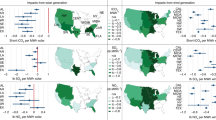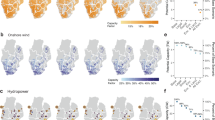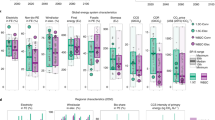Abstract
Carbon dioxide emissions from electricity generation are a major cause of anthropogenic climate change. The deployment of wind and solar power reduces these emissions, but is subject to the variability of the weather. In the present study, we calculate the cost-optimized configuration of variable electrical power generators using weather data with high spatial (13-km) and temporal (60-min) resolution over the contiguous US. Our results show that when using future anticipated costs for wind and solar, carbon dioxide emissions from the US electricity sector can be reduced by up to 80% relative to 1990 levels, without an increase in the levelized cost of electricity. The reductions are possible with current technologies and without electrical storage. Wind and solar power increase their share of electricity production as the system grows to encompass large-scale weather patterns. This reduction in carbon emissions is achieved by moving away from a regionally divided electricity sector to a national system enabled by high-voltage direct-current transmission.
This is a preview of subscription content, access via your institution
Access options
Subscribe to this journal
Receive 12 print issues and online access
$209.00 per year
only $17.42 per issue
Buy this article
- Purchase on Springer Link
- Instant access to full article PDF
Prices may be subject to local taxes which are calculated during checkout




Similar content being viewed by others
References
Hansen, J. et al. Climate impact of increasing atmospheric carbon dioxide. Science 213, 957–966 (1981).
Campbell, K. M. et al. The Age of Consequences: The Foreign Policy and National Security Implications of Global Climate Change (Center for Strategic & International Studies, 2007).
Lobell, D. B. et al. Prioritizing climate change adaptation needs for food security in 2030. Science 319, 607–610 (2008).
Fischlin, A. et al. in Climate Change 2007: Impacts, Adaptation and Vulnerability (eds Parry, M. L., Canziani, O. F., Palutikof, J. P., van der Linden, P. J. & Hanson, C. E.) 211–272 (IPCC, Cambridge Univ. Press, 2007).
Herring, S. C., Hoerling, M. P., Peterson, T. C. & Stott, P. A. (eds) Explaining extreme events of 2013 from a climate perspective. Bull. Am. Meteorol. Soc. 95, S1–S96 (2014).
World Energy Outlook 2013 169–197 (International Energy Agency, 2013).
Climate Change 2014: Mitigation of Climate Change 1335, Table A.III.2 (ed. Schlömer, S.) (IPCC, Cambridge Univ. Press, 2014).
Renewable Electricity Futures Study Report No. NREL/TP-6A20-52409 (National Renewable Energy Laboratory, 2012).
Nastrom, G. D., Gage, K. S. & Jasperson, W. H. Kinetic energy spectrum of large- and mesoscale atmospheric processes. Nature 310, 36–38 (1984).
Loulou, R., Goldstein, G. & Noble, K. Documentation for the MARKAL Family of Models (Energy Technology Systems Analysis Programme, 2004); http://www.iea-etsap.org/web/MrklDoc-I_StdMARKAL.pdf
US Energy Information Administration The Electricity Market Module of the National Energy Modeling System: Model Documentation Report Report No. DOE/EIA-M068 (US Department of Energy, 2011).
World Energy Model Documentation 2015 Version (International Energy Agency, 2015); http://www.worldenergyoutlook.org/media/weowebsite/2015/WEM_Documentation_WEO2015.pdf
Short, W. et al. Regional Energy Deployment System (ReEDS) Report No. NREL/TP-6A20-46534 (US Department of Energy, 2011).
National Renewable Energy Laboratory Renewable Electricity Futures Study Report No. NREL/TP-6A20-52409 (US Department of Energy, 2012).
Fripp, M. Switch: a planning tool for power systems with large shares of intermittent renewable energy. Environ. Sci. Technol. 46, 6371–6378 (2012).
PRISM 2.0: Regional Energy and Economic Model Development and Initial Application (Electric Power Research Institute, 2013).
Blanford, G. J., Merrick, J. H. & Young, D. A clean energy standard analysis with the US-REGEN model. Energy J. 35, SI1 (2014).
Alliss, R. et al. Introducing the Renewable Energy Network Optimization Tool (ReNOT) in 91st AMS Ann. Meet. Abstract J7.2 (American Meteorological Society, 2011).
Hart, E. K. & Jacobson, M. Z. A Monte Carlo approach to generator portfolio planning and carbon emissions assessments of systems with large penetrations of variable renewables. Renew. Energy 36, 2278–2286 (2011).
Budischak, C. et al. Cost-minimized combinations of wind power, solar power and electrochemical storage, powering the grid up to 99.9% of the time. J. Power Sources 225, 60–74 (2012).
Becker, S. et al. Features of a fully renewable US electricity system: optimized mixes of wind and solar PV and transmission grid extensions. Energy 72, 443–458 (2014).
Clack, C. T. M., Xie, Y. & MacDonald, A. E. Linear programming techniques for developing an optimal electrical system including high-voltage direct-current transmission and storage. Electr. Power Energy Syst. 68, 103–114 (2015).
Benjamin, S. G. et al. An hourly assimilation/forecast cycle: the RUC model. Mon. Weath. Rev. 132, 495–518 (2004).
Clack, C. T. M. et al. Demonstrating the effect of vertical and directional shear for resource mapping of wind power. Wind Energy http://dx.doi.org/10.1002/we.1944 (2015).
Federal Energy Regulatory Commission Form 714 (2006–2008) (US Department of Energy); http://www.ferc.gov/docs-filing/forms/form-714/data.asp
Lew, D. et al. Sub-Hourly Impacts of High Solar Penetrations in the Western United States (National Renewable Energy Laboratory, US Department of Energy, 2012); http://www.nrel.gov/docs/fy12osti/56171.pdf
Energy Information Administration Electric Power Annual 2012 (US Department of Energy, 2012); http://www.eia.gov/electricity/annual/pdf/epa.pdf
Meah, K. & Ula, S. Comparative evaluation of HVDC and HVAC transmission systems. In Power Eng. Soc. General Meeting (IEEE, 2007); http://dx.doi.org/10.1109/PES.2007.385993
Energy Information Administration Annual Energy Outlook (US Department of Energy, 2015); http://www.eia.gov/forecasts/aeo
Macknick, J., Newmark, R., Heath, G. & Hallett, K. C. A Review of Operational Water Consumption and Withdrawal Factors for Electricity Generating Technologies Report No. NREL/TP-6A20-50900 (US Department of Energy, 2011).
Natural Gas Report (US Energy Information Administration, accessed 1 November 2014); http://www.eia.gov/dnav/ng/ng_pri_sum_a_EPG0_PEU_DMcf_m.htm
Acknowledgements
The authors would like to thank M. Marquis and A. Reiser for their comments on the paper. The Office of Oceanic and Atmospheric Research at the National Oceanic and Atmospheric Administration provided funding for the project.
Author information
Authors and Affiliations
Contributions
A.E.M. developed the original concept. C.T.M.C. wrote the majority of the paper along with help from all the other authors. C.T.M.C. produced all the figures and associated data. C.T.M.C. devised, ran and computed the results for all of the experiments, created and developed the mathematical optimization along with the associated software, and wrote the Supplementary Information. C.T.M.C. also finalized the spatial, load and transmission data sets for the optimization routine. A.A. created the initial spatial availability and electrical load data sets, and compiled the original weather data sets. A.D. computed the costs for each technology. J.W. verified the weather data and assisted extensively with editing the paper. Y.X. helped with the initial optimization approach and verified the mathematical approach. All authors contributed to data review and consistency checks.
Corresponding authors
Ethics declarations
Competing interests
The authors declare no competing financial interests.
Supplementary information
Supplementary Information
Supplementary Information (PDF 10520 kb)
Rights and permissions
About this article
Cite this article
MacDonald, A., Clack, C., Alexander, A. et al. Future cost-competitive electricity systems and their impact on US CO2 emissions. Nature Clim Change 6, 526–531 (2016). https://doi.org/10.1038/nclimate2921
Received:
Accepted:
Published:
Issue Date:
DOI: https://doi.org/10.1038/nclimate2921
This article is cited by
-
The error induced by using representative periods in capacity expansion models: system cost, total capacity mix and regional capacity mix
Energy Systems (2024)
-
A net-zero emissions strategy for China’s power sector using carbon-capture utilization and storage
Nature Communications (2023)
-
Sustainable development pathways for energies in Yangtze River Delta urban agglomeration
Scientific Reports (2023)
-
Ethics of Nuclear Energy in Times of Climate Change: Escaping the Collective Action Problem
Philosophy & Technology (2022)
-
Fuel Cell Reactors for the Clean Cogeneration of Electrical Energy and Value-Added Chemicals
Electrochemical Energy Reviews (2022)



